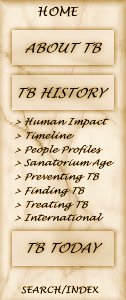Treatments of Tuberculosis |
|||||||||||||||||||||

|
|
|
|||||||||||||||||||
|
In 1928 Fleming first noticed that bacterial growth was suppressed in the neighbourhood of a patch of green mould, Penicillium notatum, which had contaminated one of the culture plates. For several years he used crude extracts of this mould to suppress the growth of certain bacteria when he wanted to isolate others, more resistant to it, from their midst. He also noticed that it was not at all toxic to human blood cells and suggested that it might be used to treat human infections. It was not until 1940 that Florey, a New Zealander working at Oxford, with his associates managed to isolate and produce a large enough quantity of penicillin to test it on patients. Their results were outstanding. Not only is it effective against a wide range of the common bacterial diseases, but it is practically non-toxic to humans. The discovery of penicillin stimulated search for antibiotics in many parts of the world and numerous substances were discovered, products of various kinds of moulds, bacteria, or plants which would kill other bacteria. But the great majority of these were unsuitable for medical use. They were either too poisonous or too difficult to purify or liable to degenerate on keeping; or, for some reason or other, they failed to meet the special requirements needed for a chemotherapeutic drug. Researchers began to feel that perhaps penicillin was unique in the field of antibiotics. It certainly is a remarkable coincidence that the first antibiotic to be tested at all thoroughly proved such a wonderful drug, whereas hundreds which were subsequently tested proved duds. However, in 1944 Dr. S. A. Waksman in the United States in some soil from the Andes in South America isolated a bacterium called Actinomyces griseus. Bacteria which do not divide up into separate cells but instead grow as long continuous branching threads are called Actinomyces, or under an earlier system of naming bacteria – Streptomyces. This particular bacterium produced a substance which killed many of the bacteria unaffected by penicillin including the tubercle bacillus. He called it streptomycin since he had given the name actinomycin to an earlier discovered antibiotic ruled out at that time as too toxic to animals. The discovery of a substance effective against the tubercle bacillus was a great event because doctors were beginning to think there might be some peculiar feature of this bacterium which rendered it immune to chemotherapy. Research workers, however, had known this was not so, for about two years before streptomycin was discovered, a substance called "promin" had been found which had proved partly successful in curing experimental tuberculosis in guinea-pigs but it was too toxic for internal use in humans. It could be applied to the skin and was of some use in treating a rare form of tuberculosis – lupus – in which the skin is involved. Furthermore, for many years two drugs had been used to treat leprosy, a disease caused by a bacterium closely resembling the tubercle bacillus, and in a few parts of the world doctors had claimed some success when these drugs were given to tuberculosis patients. A disappointing feature of streptomycin treatment is that after an interval the tubercle bacilli become resistant to it. Sulfetrone appeared to prevent, or at least delay, the development of this resistance to streptomycin on the part of the bacteria. It has since been replaced by the more effective para-aminosalicylic acid developed in France which we are all familiar with under the abbreviation PAS. Sulfetrone has passed out of the tuberculosis picture but it is interesting to note that it has proved a great success in the treatment of leprosy. In 1951 isoniazid was added to our anti-tuberculosis pharmacy, which patients are familiar with as INH (another abbreviation for a tongue-twisting chemical name). This substance had been known for some time but the credit for trying it as a drug in tuberculosis goes to a group of workers at the Seaview Hospital in New York who tried it first on tubercle bacilli in the test-tube, then on infected mice, and, finally, with mounting excitement on human patients. It proved the best drug that has yet been found for the treatment of tuberculosis. Treatment of tuberculosis by drugs does not produce the rapid cure that is seen in other diseases because the tubercle bacilli causes tubercles or granules of dead tissue in the body. These tubercles are not easily penetrated by the drug and thus the bacilli are protected to a large extent by the dead material around them. Treatment, therefore, has to be prolonged in order to give the drugs an opportunity to seep into the larger tubercles; and the larger the tuberculous masses of dead tissue are, the less likely are we to be successful in penetrating them with the drug and eliminating the bacilli. This is, therefore, one of. the reasons why we recommend surgical excision where possible of large tuberculous masses. In these cases drug treatment prevents spread of the disease by killing any bacilli which escape from the tuberculous masses, and thus surgery is made safe from the risk of spreading infection; but drug treatment alone cannot in these circumstances eliminate the deep-seated bacilli. Modified from "Chemotherapy 2" by Dr. AG Richards, a physician at the Saskatoon Sanatorium, in the 1954 Valley Echo [volume 35(4), pages 2-3]. | |||||||||||||||||||||

